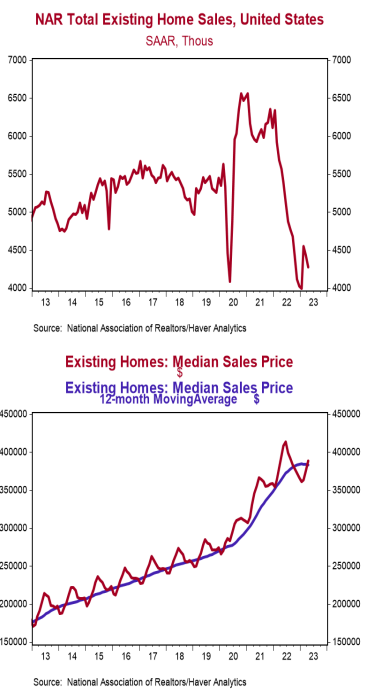- Existing home sales declined 3.4% in April to a 4.280 million annual rate, narrowly lagging the consensus expected 4.300 million. Sales are down 23.2% versus a year ago.
- Sales in April fell in every major region. The drop was due to both single-family homes and condos/co-ops.
- The median price of an existing home rose to $388,000 in April (not seasonally adjusted) but is down 1.7% versus a year ago.
Implications:
Existing home sales slipped 3.4% in April as homebuyers continue to a navigate a challenging housing market. We expect the outlook to be choppy moving forward as the housing market faces a series of crosswinds. First, mortgage rates that are currently hovering near 7% remain a headwind to activity. Assuming a 20% down payment, the rise in mortgage rates since the Federal Reserve began its current tightening cycle in March 2022 amounts to a 27% increase in monthly payments on a new 30-year mortgage for the median existing home. The shock of higher financing costs on non-homeowners (potential buyers) meant a short-term reduction in sales in 2022; but that negative impact should be diminishing as people adapt to a higher level of rates. While financing costs remain a burden, the good news for prospective buyers is that median prices have fallen 1.7% in the past year, which should help boost future sales. Meanwhile, many homeowners will be reluctant to sell due to a “mortgage lock-in” phenomenon, after buying or refinancing at much lower rates before 2022. That should limit future sales (and inventories). While we expect a continued moderation in national listing prices, a tight inventory of existing homes should prevent a repeat of 2008. Case in point, the months’ supply of homes (how long it would take to sell existing inventory at the current very slow sales pace) was 2.9 in April, well below the benchmark of 5.0 that the National Association of Realtors uses to denote a normal market. Finally, a weaking economy in which the Federal Reserve doesn’t act quickly to cut rates, because of high inflation, could be a headwind for home sales later this year. On top of this, new fee changes that went into effect May 1st as part of the Federal Housing Finance Agency’s push for affordable housing will effectively subsidize homebuyers and refinancers with riskier credit ratings by charging higher fees to those with good credit scores. These changes are likely to cause extreme confusion and result in pricier monthly mortgage payments for most homebuyers. Adding this altogether, expect sales and prices to drag on in the year ahead, with no persistent recovery in housing until at least late 2023 or early 2024. In employment news this morning, initial claims for jobless benefits fell 22,000 last week to 242,000. Continuing claims declined 8,000 to 1.799 million. Notably, it was recently discovered that much of the apparent uptrend in national initial jobless claims can be attributed to massive, organized fraud in the state of Massachusetts. Until these data are corrected, investors should be careful interpreting any perceived trends. In other news this morning, the Philadelphia Fed Index, which measures manufacturing sentiment in that region, rose to a still weak reading of -10.4 in May from -31.3 in April. These data are consistent with a weakening economy and our view of an impending recession in 2023.





